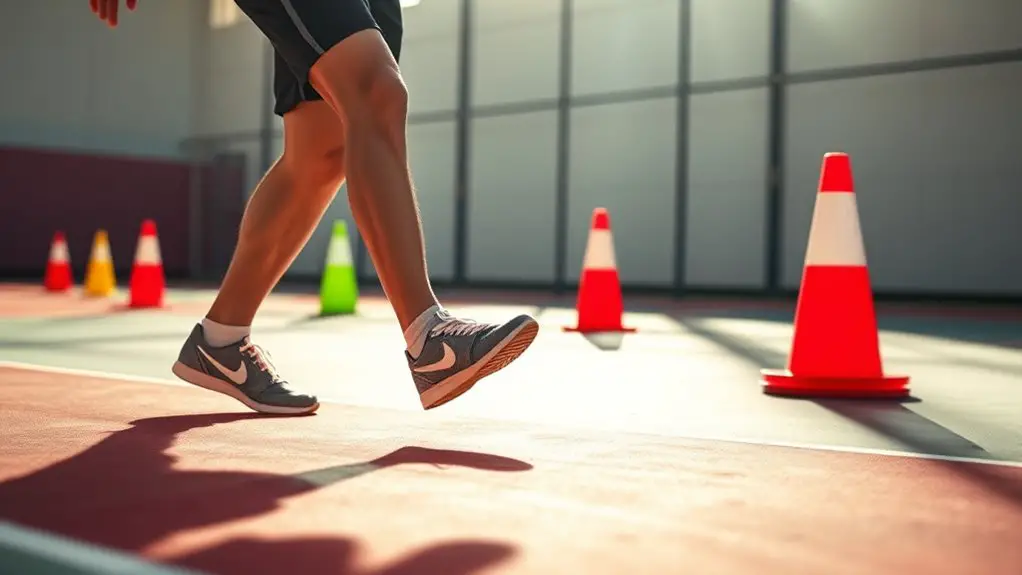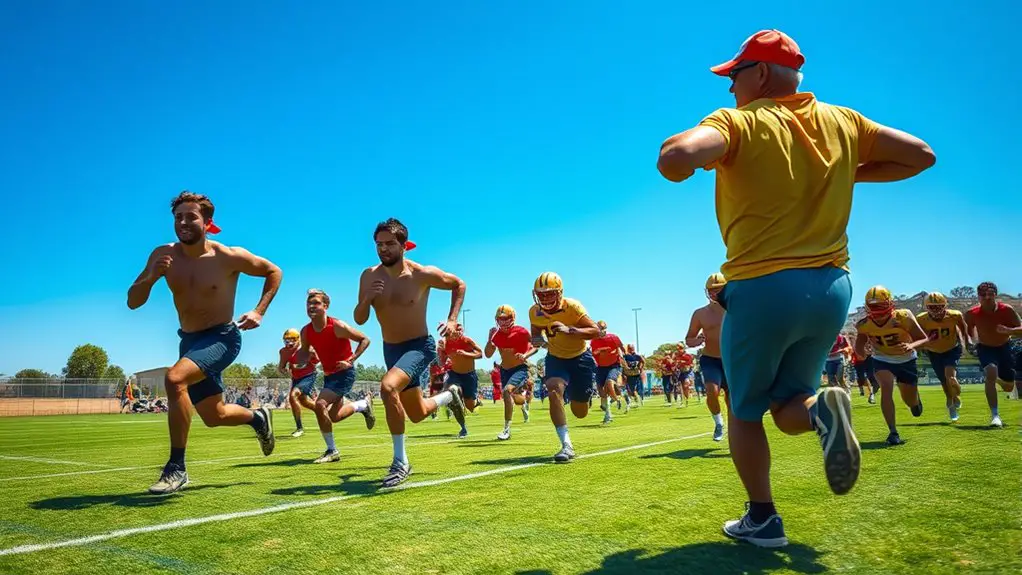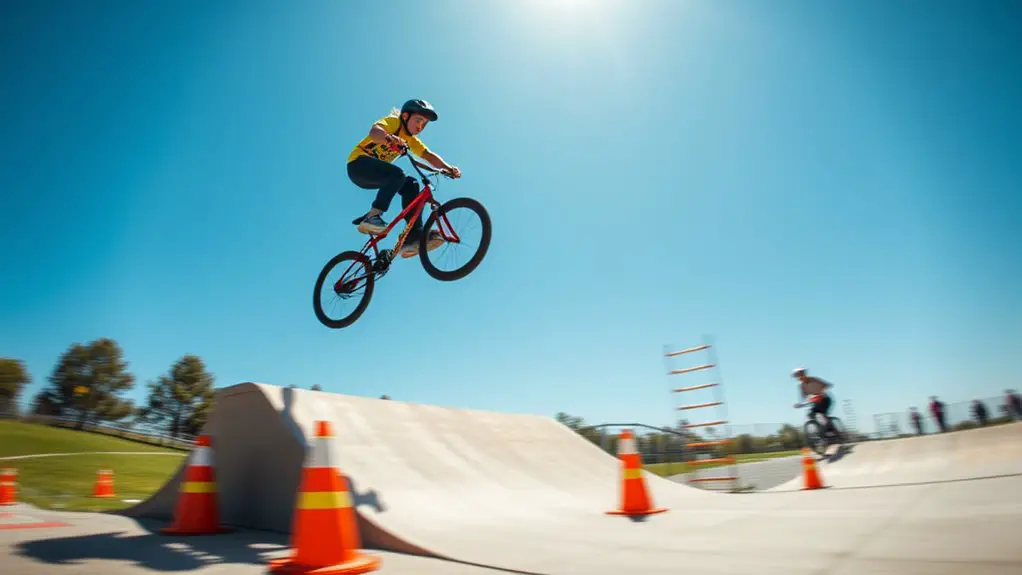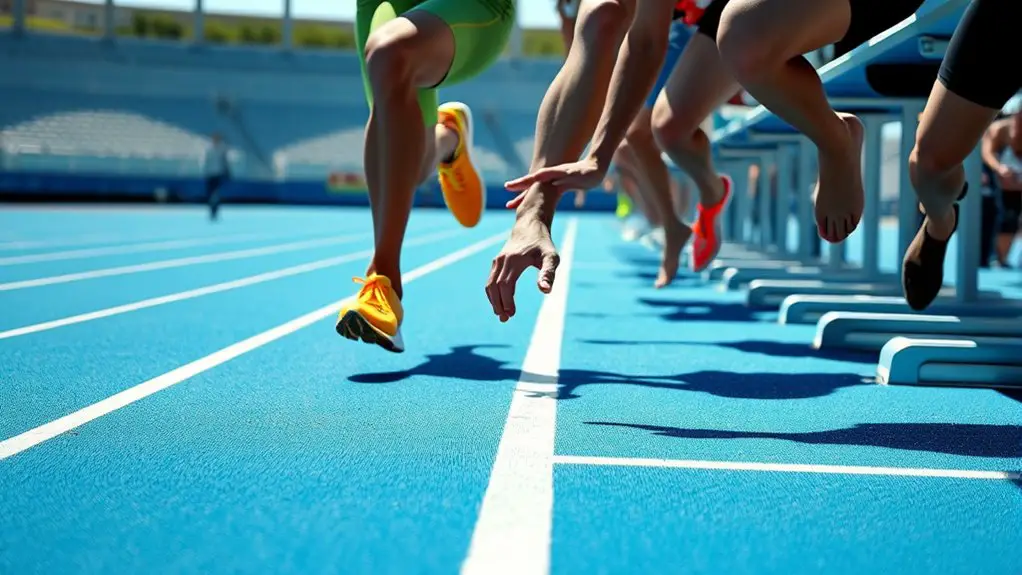To improve your footwork for faster lateral movement, focus on agility, balance, and strength. Start with dynamic warm-ups like high knees and lateral shuffles. Incorporate agility ladder drills to enhance foot speed and coordination. Plyometric exercises will help you develop explosive power. Resistance training can also boost your foot speed. Finally, try sport-specific drills to translate these skills directly into your game. There's so much more to explore regarding techniques and progress tracking!
Understanding the Importance of Lateral Movement
While many athletes focus on speed and agility in a straight line, understanding the importance of lateral movement can elevate your performance considerably. Embracing lateral agility isn't just about shifting your weight; it's about mastering quick direction changes that can give you an edge over your competition. Whether you're on the court, field, or track, being able to move side to side with fluidity allows you to dodge opponents and respond to plays effortlessly.
When you prioritize lateral movement, you're not just improving your footwork; you're enhancing your overall athleticism. The freedom to navigate your environment with confidence means you can release your full potential. Plus, incorporating drills that emphasize lateral agility will build strength in your hips and legs, making those quick direction changes feel natural. Strength training enhances muscle power for directional changes, which is essential for maximizing your performance. So, don't underestimate the power of side-to-side movement; it's a game-changer for any athlete looking to break free from limitations.
Key Components of Effective Footwork
To improve your lateral movement, you need to focus on two key components: balance and stability, along with agility and coordination. These elements work together to enhance your footwork, making it easier to change directions quickly. By mastering them, you'll see significant improvements in your overall performance. Additionally, proper footwork can reduce the risk of injuries, allowing you to train and compete more effectively.
Balance and Stability
Achieving effective footwork heavily relies on balance and stability, as these elements allow you to move swiftly and confidently in any direction. Incorporating balance exercises and stability techniques into your routine can markedly enhance your footwork. Here's a simple table to guide you:
| Balance Exercises | Stability Techniques | Benefits |
|---|---|---|
| Single-leg stands | Core strengthening | Improves posture |
| Balance beams | Resistance band work | Enhances control |
| Stability balls | Dynamic movements | Increases agility |
Agility and Coordination
Balance and stability lay the groundwork for enhancing agility and coordination, two key components of effective footwork. To really take your lateral movement to the next level, incorporate agility drills and coordination exercises into your routine. These activities will not only sharpen your skills but also give you the freedom to move fluidly.
- Ladder drills: Improve foot speed and precision.
- Cone drills: Boost change-of-direction abilities.
- Balance exercises: Enhance stability and core strength.
Warm-Up Exercises for Enhanced Agility
Although many athletes overlook the importance of warm-up exercises, incorporating agility drills into your routine can greatly enhance your lateral movement. Starting with dynamic stretching and mobility drills can help prepare your body for action, allowing for increased flexibility and reduced risk of injury. Here are some effective exercises to contemplate:
| Exercise | Duration | Benefits |
|---|---|---|
| High Knees | 30 sec | Increases heart rate |
| Lateral Shuffles | 30 sec | Enhances lateral speed |
| Leg Swings | 30 sec | Improves hip mobility |
| Butt Kicks | 30 sec | Activates hamstrings |
| Walking Lunges | 30 sec | Engages lower body |
Incorporate these movements into your warm-up to release your potential. By prioritizing agility, you set the stage for outstanding performance on the field or court. Embrace the freedom of movement! Additionally, these warm-up exercises can significantly enhance your footwork skills, which are crucial for effective lateral movement.
Basic Footwork Drills to Get Started
To master lateral movement, you need to focus on basic footwork drills that build a strong foundation. These foundational footwork exercises improve your agility and help you move with greater ease. Here are three basic lateral drills to get you started:
Master lateral movement by focusing on foundational footwork drills that enhance agility and ease of movement.
- Side Shuffles: Move sideways in a crouched position, keeping your feet low to the ground. This helps strengthen your legs and improve your lateral speed.
- Lateral Bounds: Jump side to side, landing softly while maintaining balance. This drill enhances your stability and quickness.
- Carioca Drills: Move laterally while crossing your feet in a rhythmic motion. This drill increases coordination and foot speed.
Incorporate these basic lateral drills into your routine, and you'll notice significant improvements in your lateral movement. With consistent practice, you'll feel more fluid and free during your activities. Additionally, these drills are excellent for improving overall agility and can lead to enhanced athletic performance.
Plyometric Exercises for Explosive Lateral Movement
Building on those foundational footwork drills, incorporating plyometric exercises can take your lateral movement to the next level. Start by using a plyometric box for jump squats, which build power in your legs. Add lateral hops to enhance your side-to-side agility, making those quick feet even quicker. Incorporate bounding drills to develop explosive starts, helping you accelerate in any direction.
Agility hurdles can elevate your footwork, allowing you to practice side shuffles while maintaining speed. Use resistance bands during these exercises to increase strength and stability, giving you that extra edge. Speed ladders are fantastic for improving coordination and rhythm, making lateral movements feel effortless. Additionally, focusing on fast-twitch muscle fibers can significantly enhance your explosive power during these plyometric movements.
Incorporating Agility Ladders Into Your Training
When you want to enhance your lateral movement, incorporating agility ladders into your training routine can be a game changer. Agility ladders are perfect for developing quick footwork and improving your overall agility. Plus, they offer several benefits that can elevate your performance:
Incorporating agility ladders into your routine can dramatically enhance your lateral movement and footwork.
- Increased foot speed: You'll notice a significant boost in your lateral quickness.
- Enhanced coordination: Your body will learn to move more fluidly and efficiently.
- Versatility: With numerous agility ladder variations, you can keep your workouts fresh and engaging.
Try incorporating different patterns and drills to maximize the agility ladder benefits. Whether you're doing side shuffles, in-and-out steps, or crossover runs, each variation targets your footwork in unique ways. Additionally, these drills can help with quick feet essential for improving foot speed and agility in wide receivers. Embrace this freedom in your training, and watch your lateral movement improve dramatically!
Resistance Training for Improved Foot Speed
To boost your foot speed, incorporating resistance training is key. Plyometric drills, weighted exercises, and agility ladder workouts can all enhance your lateral movement. Let's explore how each of these components contributes to faster footwork. Additionally, focusing on core stability and strength can significantly improve your overall agility and movement efficiency.
Plyometric Drills Benefits
While many athletes focus on traditional strength training, incorporating plyometric drills can greatly enhance your foot speed and agility. These dynamic exercises offer numerous plyometric benefits that help you develop explosive strength, allowing for quicker lateral movements on the field or court. Here are a few key advantages of adding plyometric drills to your routine:
- Improved muscle elasticity: Helps you generate force more quickly, enhancing your reaction time.
- Increased power output: Boosts your overall athletic performance by training your muscles to exert maximum force.
- Enhanced coordination: Refines your body's ability to move fluidly and efficiently during rapid changes in direction.
Embracing plyometric drills can free you to release your full potential in any sport!
Weighted Resistance Exercises
Incorporating weighted resistance exercises into your training routine can greatly boost your foot speed, especially during lateral movements. Using weighted sleds and resistance bands can add that extra challenge you need to enhance your agility. When pulling a sled, you'll engage your core and legs, building strength and speed simultaneously. Resistance bands can also be anchored to a stable surface, allowing you to practice lateral shuffles against resistance, which helps develop those fast-twitch muscle fibers. By integrating these exercises, you're not just building strength; you're training your body to respond quicker. Embrace the freedom to explore these tools, and you'll find yourself moving faster and more efficiently on the court or field. Don't underestimate the power of resistance training!
Agility Ladder Workouts
Agility ladder workouts are a fantastic way to enhance your foot speed and agility, particularly for lateral movement. These drills are not just about speed; they help develop coordination and balance, giving you the freedom to move fluidly on the field or court.
Try incorporating these agility ladder drills into your routine:
- Side shuffle: Focus on quick steps and maintaining proper posture.
- In-and-out hops: Jump in and out of the ladder, keeping your feet light.
- Single-leg hops: Balance on one leg while hopping through the ladder for added challenge.
Practicing these ladder footwork techniques will not only improve your speed but also boost your overall athletic performance. So, grab that ladder and get to work!
Sport-Specific Drills to Enhance Performance
To boost your lateral movement and overall performance, incorporating sport-specific drills can make a significant difference. Engaging in drills tailored to your sport allows you to practice sport-specific techniques that directly translate to competitive scenarios. For basketball, try lateral shuffles combined with shooting drills; this builds speed while ensuring you're always ready for a quick move. If you're into soccer, incorporate cone drills that mimic the sidesteps needed for defensive plays.
In tennis, work on side-to-side sprints while practicing your volleys. These activities not only enhance your footwork but also immerse you in the rhythms of your sport. By regularly integrating these drills into your training, you'll cultivate the agility needed to navigate the court or field with ease, helping you stay ahead of the competition. Embrace the freedom to move dynamically and watch your performance soar! Additionally, practicing agility drills can significantly improve your ability to change direction quickly and effectively during play.
Techniques for Maintaining Balance and Stability
To improve your lateral movement, mastering proper stance mechanics is essential for maintaining balance. Incorporating core strength exercises will enhance your stability during quick shifts. Additionally, using visual focus techniques can help you stay grounded and aware of your surroundings. Furthermore, developing core strength is crucial as it supports overall balance and stability during dynamic movements.
Proper Stance Mechanics
While mastering lateral movement is essential for athletic performance, proper stance mechanics play an important role in maintaining balance and stability. Adopting the right stance guarantees you're ready to move fluidly and quickly. Focus on these key elements:
- Stance width: Keep your feet shoulder-width apart for ideal balance.
- Foot placement: Angle your toes slightly outward to enhance stability and mobility.
- Knee alignment: Confirm your knees align with your toes, preventing unnecessary strain.
When you apply these principles, you'll find yourself more grounded and responsive during lateral movements. Remember, a solid foundation allows for quicker shifts and better control, giving you the freedom to move with confidence on the field or court. Embrace these mechanics, and watch your performance soar!
Core Strength Exercises
As you work on improving your lateral movement, incorporating core strength exercises is essential for maintaining balance and stability. A strong core enhances your core stability, allowing you to execute dynamic movements with ease. Try planks and side planks to build endurance in your core. Incorporate rotational exercises like medicine ball twists to engage your obliques, which are vital for lateral shifts. Consider adding stability ball exercises to challenge your balance further, helping you adapt quickly during gameplay. Remember, a strong core isn't just about aesthetics; it's about giving you the freedom to move fluidly and confidently. So, embrace these exercises, and you'll notice a significant boost in your lateral movement and overall agility.
Visual Focus Techniques
Maintaining visual focus is essential for enhancing your balance and stability during lateral movement. By honing in on visual cues, you can improve your body awareness and responsiveness. Here are some focus drills to incorporate into your training:
- Track moving objects: Use balls or other items to challenge your focus while shifting laterally.
- Mirror practice: Stand in front of a mirror to observe your form and maintain visual alignment.
- Weighted gaze: Hold a lightweight object in one hand, keeping your eyes on it as you move side to side, enhancing stability.
These techniques will not only boost your lateral speed but also give you a sense of freedom as you confidently navigate your space. Embrace the power of visual focus!
Tracking Progress and Making Adjustments
To effectively track your progress in improving footwork for lateral movement, it is crucial to establish clear benchmarks and regularly assess your performance. Start by recording your times during drills or your agility in specific exercises. This progress tracking not only highlights where you're excelling but also reveals areas needing attention.
Once you've gathered data, don't hesitate to implement adjustment strategies. If you notice a plateau, mix up your drills or increase the intensity. Experiment with different techniques, like changing your stance or incorporating resistance training. Remember, flexibility in your training approach can lead to breakthroughs.
Regularly revisit your benchmarks and adjust your goals as you improve. Celebrate your achievements—no matter how small—and stay open to trying new methods. This way, you'll keep your training fresh and your motivation high, leading to faster lateral movement and enhanced overall performance.
Frequently Asked Questions
How Can Diet Impact My Footwork and Agility Training?
Your diet plays an essential role in your footwork and agility training. By focusing on nutrition timing, you can fuel your body properly before and after workouts, maximizing performance and recovery. Don't underestimate hydration strategies, either; staying well-hydrated enhances your overall agility and reaction time. When you nourish yourself effectively, you'll feel lighter and more agile, allowing you to move freely and confidently, achieving the results you're working towards.
What Are Common Injuries Related to Poor Footwork?
When it comes to common injuries from poor footwork, ankle sprains and knee injuries are at the top of the list. You might find yourself twisting an ankle during quick pivots or feeling strain in your knees from improper landing. These injuries can limit your freedom and hinder your performance, so it's essential to pay attention to your technique. By improving your footwork, you can avoid these setbacks and keep moving with confidence.
How Often Should I Practice Footwork Drills?
You should aim to practice footwork drills at least two to three times a week. It's all about finding the right balance in your training schedule. Too little and you won't see improvement, but too much can lead to burnout. By incorporating footwork drills regularly, you'll enhance your agility and movement, giving you that freedom to move effortlessly on the field or court. Consistency is key, so make it a fun part of your routine!
Can I Improve Footwork Without Access to a Gym?
Absolutely, you can improve your footwork without hitting the gym! Just focus on agility exercises that you can do right at home. Think about ladder drills using tape on your floor or quick feet drills in your living room. Incorporate at home routines that challenge your balance and speed, like hopping or lateral shuffles. With a little creativity, you'll boost your footwork and feel free to train whenever you want!
What Shoes Are Best for Enhancing Lateral Movement?
When choosing shoes for enhancing lateral movement, look for features like a wide toe box, supportive midsoles, and a good grip. Brands like Nike and Adidas often offer models designed for agility. You might find that Asics provide excellent stability, while New Balance can be great for comfort. Don't hesitate to try different brands to see what suits your foot shape and style best. Your freedom of movement depends on the right fit!




